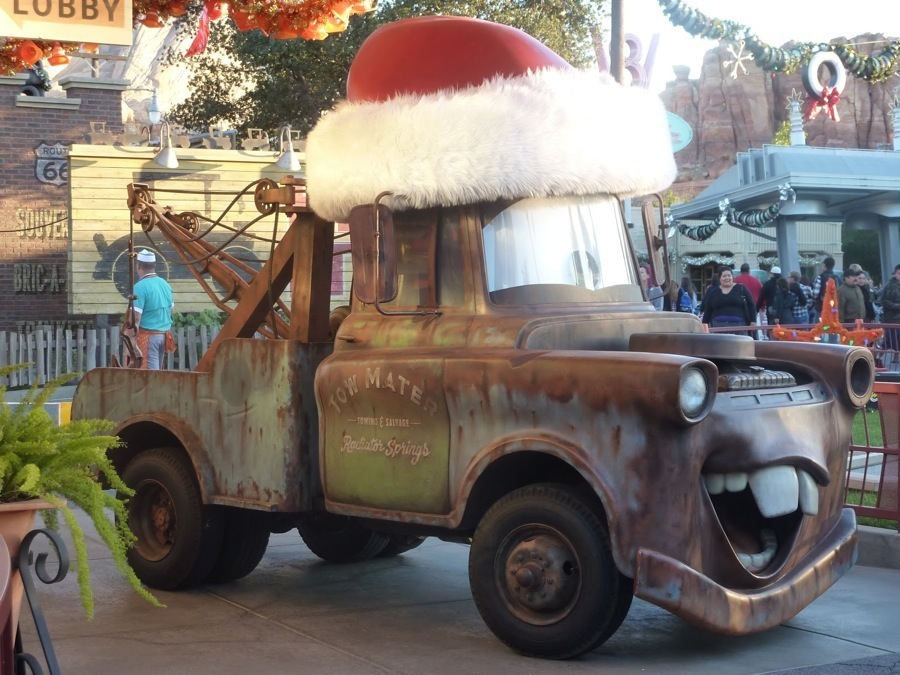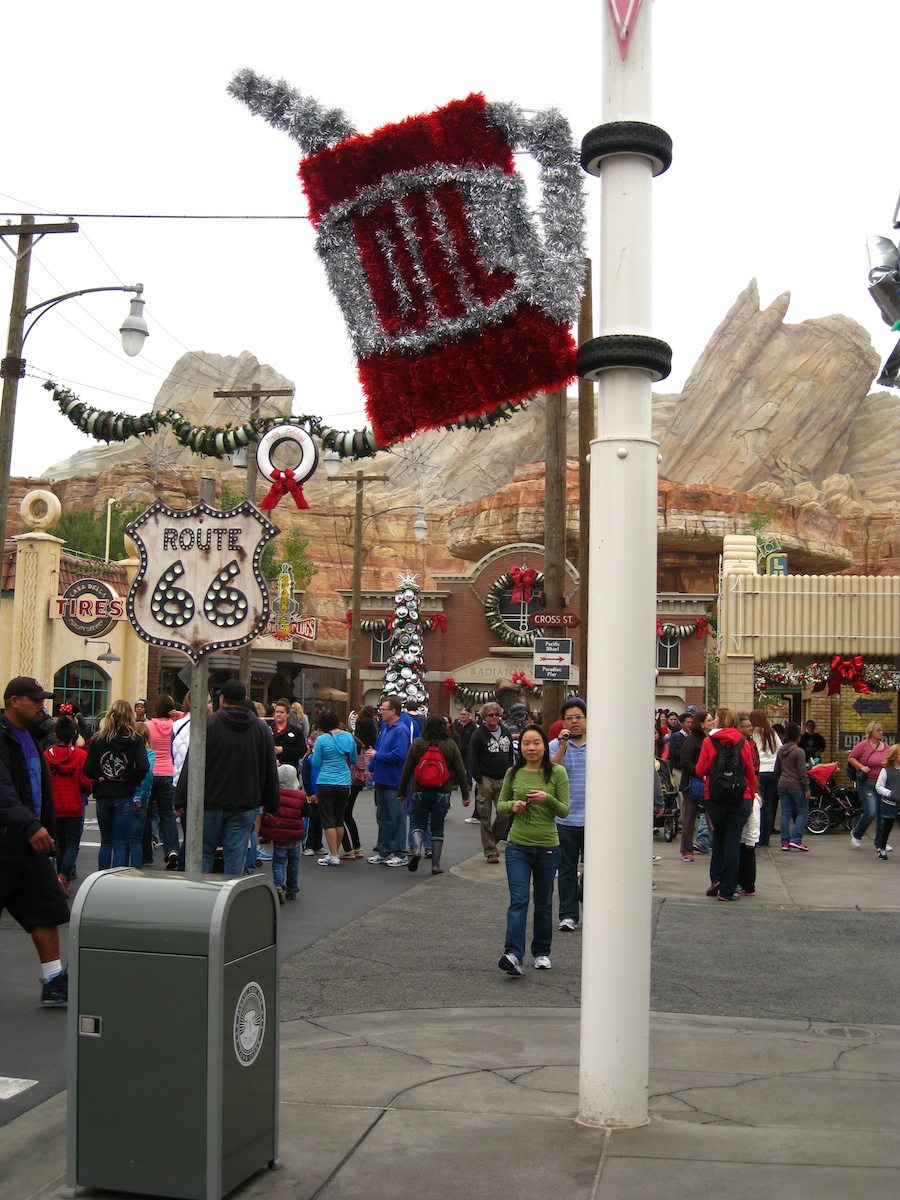Christmas Time Means Robin Has A Birthday
...and we are off to Disneyland to spend the day!

We arrived right on time....

Mickey greeted us

The Five and Dime brings back memories of Paul Senior
Did You Know? - Five and dime (also known as five-cent stores, dime stores, and ten-cent stores) is a type of store that was popular in the early to mid-20th century. They sold many different items, most of which were worth five or ten cents

Here comes the "Red Car"

A refurbished car
Did You Know? - The Pacific Electric Railway (reporting mark PE), also known as the Red Car system, was a mass transit system in Southern California using streetcars, light rail, and buses. The largest electric railway in the world at its greatest extent, around 1925, the system interconnected cities in Los Angeles County and Orange County, as well as in San Bernardino County and Riverside County.
The service was organized around two nexuses located in the city centers of Los Angeles and San Bernardino, which were each connected in 1914 by the 1200-volt San Bernardino Line.
We Arrive At Cars Land

Decorated up for Christmas

Tow-Mater was dressed for the occasion

Neat trees

Neat decorations

What to do with old tires

Go patriotic tree *before the government bans them!)

Talk about being wrapped up

Check the battery on this tree

This tree will not squeak

Checkout the light post decoration

Sue gives the place a once over

The Cars ride was having some technical difficulties and a 90 minute wait....

City Hall is all decked out
Did You Know? - Radiator Springs Racers is a slot car dark ride attraction in Cars Land at Disney California Adventure. The attraction features third-generation Test Track technology, an attraction located at Epcot in Walt Disney World. Radiator Springs Racers is themed to the fictional world from Disney·Pixar's Cars.
The attraction is the most expensive to be built in the entire Disneyland Resort, one of the most expensive attractions Disney has ever built, and one of the most expensive theme park attractions in the world at an estimated cost of over $200 million, which took up about 18% of the entire cost of the $1.1 billion expansion plan for Disney California Adventure Park.
The attraction takes guests in a six-person vehicle through a briefing with Doc and Lighting McQueen, characters from the film Cars. Guests race another guest vehicle through turns and banks, ending with a randomized race result.

Keep your old hubcaps

Hubcap tree
Did You Know? - When pressed steel wheels became common by the 1940s, these were often painted the same color as the car body. Hubcaps expanded in size to cover the lug nuts that were used to mount these steel wheels. These hubcaps were typically made from chrome-plated or stainless steel. The next development was, as an option on more expensive cars, a chrome-plated trim ring that clipped onto the outer rim of the wheel, in addition to the center hubcap. Finally came the full wheel cover, which of course covered the entire wheel.

Everyone was decorated

That there is a stack of tires

Everything is so colorful

Highway 66 three
Did You Know? - U.S. Route 66 (US 66 or Route 66), also known as the Will Rogers Highway and colloquially known as the Main Street of America or the Mother Road, was a highway within the U.S. Highway System. One of the original U.S. Highways, Route 66 was established on November 11, 1926—with road signs erected the following year.
The highway, which became one of the most famous roads in America, originally ran from Chicago, Illinois, through Missouri, Kansas, Oklahoma, Texas, New Mexico, and Arizona before ending at Los Angeles, California, covering a total of 2,448 miles (3,940 km).
It was recognized in popular culture by both a hit song and the Route 66 television show in the 1960s.
Miss Robin Arrives


Our official cameraman also arrives

Putting down the avenue

Z-o-o-o-o-o-o-m



Time For A Drink At Carthay Circle!

Bob and Paul need new suits

In 1937
Did You Know? - The Carthay Circle Theatre was one of the most famous movie palaces of Hollywood's Golden Age. It opened at 6316 San Vicente Boulevard in 1926 ] and was considered developer J. Harvey McCarthy's most successful monument, a stroke of shrewd thinking that made a famous name of the newly developed Carthay residential district in the Mid-City West district of Los Angeles, California.
The Carthay Circle Theater provided the "circle" for which Carthay Circle has come to be named. The auditorium itself was shaped in the form of a perfect circle, extended vertically into a cylinder, set inside a square that fleshed out the remainder of the building. McCarthy's development was called Carthay—an anglicized version of his last name.
The theater was called the Circle Theater for its unique floorplan. Initially developed by Fox, it was called the Fox Carthay Circle Theater. The theater became better known than the development in which it was located, and this has led to confusion in the name of the area. The theater's name meant "the Circle Theater, by Fox, located in Carthay", but became incorrectly interpreted as "The Fox Theater, located in Carthay Circle." The misintrepretation has stuck, and now the region is more or less officially known as Carthay Circle, even as its theater namesake has been gone for half a century.

The birthday card was unique.... You could blow it out

The birthday girl


A special drink for a special person

Paul did a whiskey sour


Robin poses for Bob.... Paul gets the picture

Decisions decisions

Santa is decked out in red

Come on and smile

Big smiles
Time To Head For Disneyland Proper

Snow Whites gingerbread house
Did You Know? -
Originally, the term gingerbread (from Latin zingiber via Old French gingebras) referred to preserved ginger. It then referred to a confection made with honey and spices. Gingerbread is often used to translate the French term pain d'épices (literally "spice bread") or the German term Lebkuchen (bread of life, literally: cake of life) or Pfefferkuchen (pepperbread, literally: pepper cake). The term Lebkuchen is unspecified in the German language. It can mean Leben (life) or Laib (loaf), while the last term comes from the wide range of spices used in this product.
Gingerbread was brought to Europe in 992 by the Armenian monk Gregory of Nicopolis (Gregory Makar) (Grégoire de Nicopolis). He left Nicopolis Pompeii, to live in Bondaroy (France), near the town of Pithiviers. He stayed there 7 years, and taught the Gingerbread cooking to French priests and Christians. He died in 999.
During the 13th century, it was brought to Sweden by German immigrants. Early references from the Vadstena Abbey show how the Swedish nuns were baking gingerbread to ease indigestion in 1444. It was the custom to bake white biscuits and paint them as window decorations.

California Adventure had its own Christmas Tree

A magnificent structure

The gas station was decorated for the season

Bye bye and come back soon